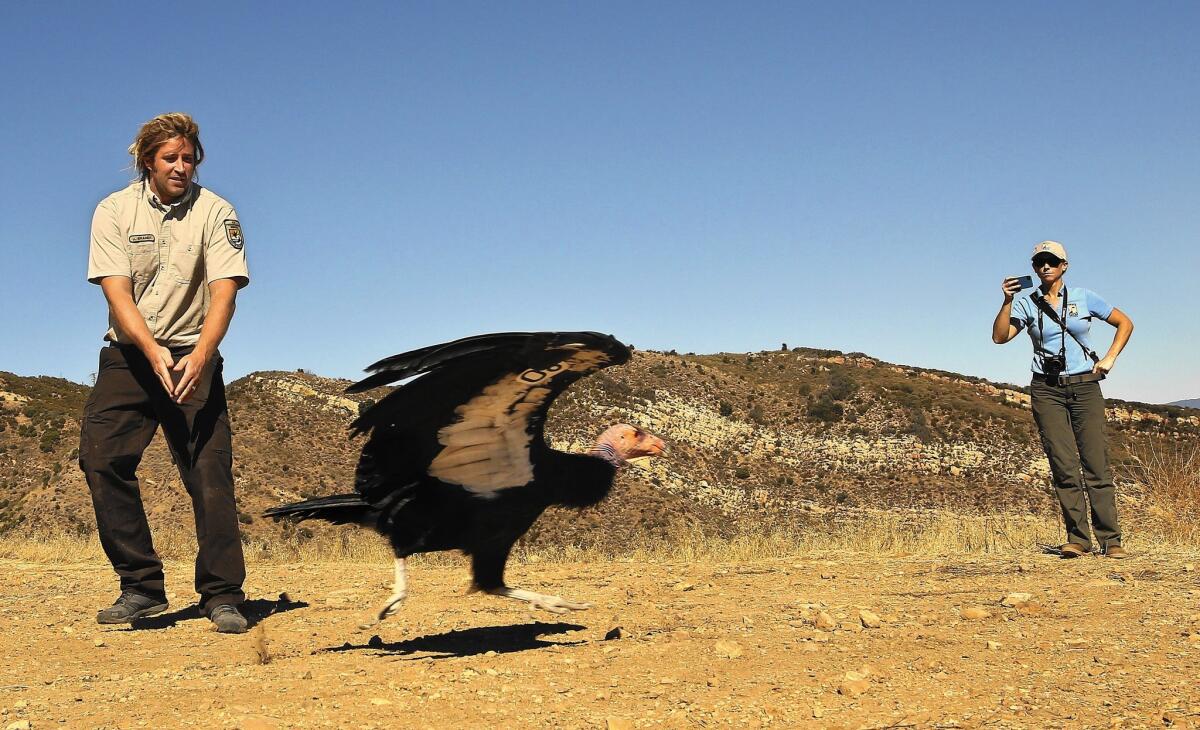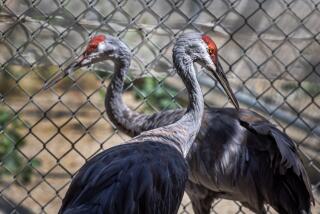Hidden video camera provides a close-up look at condor living

- Share via
Reporting from Fillmore, Calif. — A new reality TV show unfolded this year in a cave in a sandstone cliff about 75 miles northwest of Los Angeles.
While home alone and waiting for his parents to return with carrion for dinner, an energetic young male California condor played games on the floor of the cave: tossing feathers and bones into the air with his beak, then pouncing on them with blunt claws.
He also stared at his toes, lifting each one in turn as though playing a piano.
------------
FOR THE RECORD:
Condors: In the Nov. 24 California section, an article about a video camera that records the home life of California condors misspelled the last name of a Santa Barbara Zoo condor technician. Her name is Molly Astell, not Astelle. —
------------
Scientists watching through a hidden video camera were smitten. They had installed the camera and wireless transmitter as an experimental method of monitoring condors, a species slowly recovering from the brink of extinction three decades ago.
The high-resolution camera is for first time providing researchers with a full picture of home life among the enormous scavengers.
Until now, the birds — with their red-ringed amber eyes, 9 1/2-foot wingspan and razor-sharp beaks — were observed only from great distance through binoculars or spotting scopes. Scientists and volunteer nest guardians could only speculate on what was happening in the caves and hollowed-out redwood trees where condors lay one egg a year. To get a closer look, they rappelled down cliffs and climbed into the nests.
The scientists say the success of the camera holds the promise of improving the care of any number of endangered species.
“We’re already using this technique elsewhere,” said Charles Eldermire, bird cams project leader at the Cornell Lab of Ornithology.
A camera installed this year in a remote Laysan albatross nest on the Hawaiian island of Kauai is providing a more detailed, and grim, understanding of the threat posed by ingestion of plastic that is regurgitated to nestlings.
Cameras are even helping, indirectly, with the study of the effects of the environment on humans. In Missoula, Mont., cameras placed in an osprey nest are being used to identify the species of fish the birds are bringing home from a nearby river. The goal is to find out how heavy metals are being dispersed in the environment.
Around the world, online viewers have spent an estimated billion or more minutes watching live video from cameras in the nests of common species including great blue herons, red-tailed hawks and barn owls near the Cornell lab.
At the condor’s nest, the view has not always been joyful.
“Some of the footage is heartbreaking to watch,” said Molly Astelle, 29, a condor technician at the Santa Barbara Zoo who has a large condor tattooed on her right arm.
In July, the father condor was killed by a bobcat, and the mother assumed his duties of flying up to 150 miles a day in search of food for the fledgling.
In late October, the young condor failed to return from one of its first short flights from the nest. Scientists found its carcass in nearby chaparral. The mother still visits the cave every few days searching for signs that her fledgling is still alive.
The video camera, operated by the Cornell lab, the Santa Barbara Zoo and the U.S. Fish and Wildlife Service, is making management of the nest significantly safer for birds and scientists alike.
“Prior to video, we routinely entered condor nests every 30 days to collect the harmful micro-trash they bring home,” including bottle caps, electronics parts, broken glass and wire, said Joseph Brandt, a condor biologist with the Fish and Wildlife Service. Scientists also took blood samples and vaccinated for West Nile virus.
“Now, we use video footage to decide whether or not entry is even necessary,” Brandt said.
Federal scientists are considering using video cameras in condor nests elsewhere in California and in Arizona. Sometime next year, they hope to stream real-time video feeds of condor nests online.
None of that will be easy — or cheap. The biggest hurdle is that condor nests are in remote areas, which makes transmitting video difficult. The cave for the experimental video is in the Hopper Mountain National Wildlife Refuge, not far from a field station where the signal is received.
The experiment, funded in part by a $20,000 grant from the Disney Worldwide Conservation Fund, generates a torrent of data: roughly eight to 10 terabytes per year. The footage is streamed to researchers and later edited and archived at the Santa Barbara Zoo.
The remote station lacks high-speed Internet connections necessary to stream the footage online, but the public can watch clips from this year’s videos on Facebook.
Condors have been in jeopardy since the 1950s. Development encroached on condor habitat, and the now-banned pesticide DDT made condor eggshells so thin they often could not support life.
Some of the birds were shot or died of lead poisoning when they fed upon the carcasses of other animals killed with lead shot and bullets.
Scientists began recovery efforts by capturing the few remaining wild condors, breeding them in captivity and releasing the birds in their historical range. Today, the number of free-flying condors in California stands at 128, many of them hatched in the wild. The population worldwide is 433.
Barring major setbacks, the vulture that scientists know as Gymnogyps californianus may be eligible for down-listing from endangered to threatened within a few decades, researchers say.
On a recent weekday, Brandt, Astelle and Devon Pryor, a conservation and research associate at the Santa Barbara Zoo, released three rehabilitated adult condors into the furrowed mountains of Ventura County. Two of the birds had been treated for exposure to lead. The other had surgery on an injured wing.
Emerging from large dog crates, the condors took a quick look around, then raced on foot toward the edge of a bluff. Then, with black-and-white wings flapping hard, they rose into the brilliant blue sky.
Like all California condors, the 20-pounders had been fitted with number tags and radio transmitters to allow scientists to track their movements.







